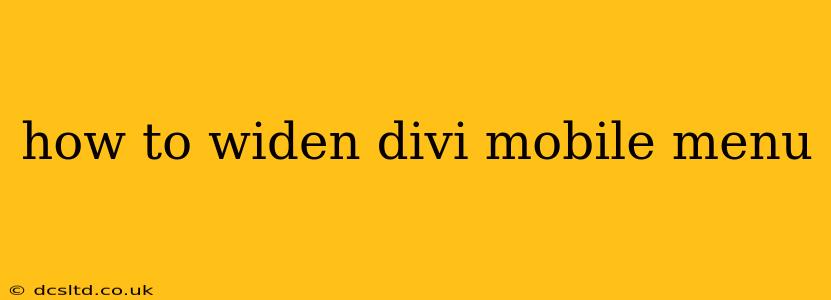Divi's mobile menu, while functional, can sometimes feel a little cramped, especially on larger-screened smartphones. This can negatively impact user experience and navigation. Luckily, there are several effective ways to widen that menu, giving your visitors a more comfortable browsing experience. This guide explores various methods, from simple CSS tweaks to using Divi's built-in options and third-party plugins.
Why Widen the Divi Mobile Menu?
Before diving into the solutions, let's understand why widening the mobile menu is crucial. A narrow menu forces users to squint, making navigation tedious and frustrating. A wider menu improves:
- Readability: Larger text and more spacing improve readability, leading to a better user experience.
- Usability: Easy navigation reduces bounce rates and increases time on site.
- Accessibility: A wider menu is more accessible to users with visual impairments.
- Professionalism: A well-designed mobile menu enhances your website's overall professionalism.
Methods to Widen Your Divi Mobile Menu
Here are the most effective approaches, catering to different levels of technical expertise:
1. Using Divi's Built-in Options (Easiest Method)
While Divi doesn't offer a direct "width" setting for the mobile menu, you can influence its size indirectly:
- Adjusting Font Size: Reducing the font size of the menu items will allow for more items to fit within the default width. This is found within the Divi Theme Options > Typography section. Experiment with smaller sizes until you find a balance between readability and width.
- Menu Item Arrangement: Organize your menu items logically and concisely. Avoid lengthy menu labels. Shorter names take up less horizontal space.
- Icon Size: If you use icons alongside menu labels, reduce their size to create more space. This is usually adjustable within the menu item settings.
This approach isn't about directly widening the menu container, but optimizing its content to better fit the existing width.
2. Custom CSS (Intermediate Method)
This method requires some familiarity with CSS but offers precise control. You'll add custom CSS to your Divi theme using the Divi Theme Builder or the Theme Options > Custom CSS area. Here's the code, but remember to adjust the width value to your preference:
@media (max-width: 767px) {
.et_mobile_nav {
width: 80% !important; /* Adjust the percentage as needed */
margin: 0 auto; /* Centers the menu */
}
}
This code targets the mobile navigation container (et_mobile_nav) and sets its width to 80% of the screen width on devices with a maximum width of 767px (a common breakpoint). The !important ensures this style overrides any conflicting styles. The margin: 0 auto; centers the widened menu.
Remember to:
- Replace
80%with your desired width. Experiment with different percentages until you achieve your ideal width. - Backup your theme: Before adding custom CSS, always back up your theme files to prevent unintended consequences.
3. Using a Divi Child Theme (Recommended for Advanced Users)
Creating a child theme is the most robust solution. It keeps your customizations separate from the parent theme, protecting your changes during theme updates. The process for creating a child theme varies slightly depending on your hosting environment. Consult the Divi documentation or your hosting provider's support for detailed instructions. Once created, you can add the same CSS as in method 2 to your child theme's style.css file.
4. Third-Party Plugins (Consider this as a Last Resort)
While generally not recommended, some third-party plugins claim to modify Divi's mobile menu. However, using plugins can add unnecessary complexity and potential compatibility issues. Before resorting to this, try the other methods first. Always carefully check plugin reviews and compatibility before installing.
Troubleshooting and Fine-tuning
- Caching: Clear your browser's cache and any caching plugins after implementing CSS changes.
- Inspect Element: Use your browser's "Inspect Element" tool (usually accessed by right-clicking) to identify the specific CSS selectors affecting the mobile menu. This helps pinpoint the correct element to target with your custom CSS.
- Responsiveness: Test the changes on various devices and screen sizes to ensure responsiveness.
By carefully considering these methods and adapting them to your specific needs, you can effectively widen your Divi mobile menu, creating a more user-friendly and enjoyable experience for your website visitors. Remember to always back up your website before making significant changes.
